Verbena lasiostachys (ver-BEE-na las-ee-oh-STAY-kis) is a deciduous perennial herb that is native to a variety of plant communities throughout California and Oregon.
This species is commonly known as Western Vervain, Common Verbena, Western Verbena, or simply Vervain. The species name, lasiostachys, is taken from the Greek lasio, meaning woolly, and stachys, meaning an ear of grain, or a spike.
We first noticed this plant back in May, growing out in the orchard in soil that was disturbed last year when we re-cut the road leading out to the gardens. We didn’t think much of it then, as it was blooming alongside various other spring blooming plants, including some hedge nettle at the time. However, with a second period of bloom in late summer, this plant has caught our attention again.
The leaves of Verbena lasiostachys are coarsely toothed, larger toward the base of the stem, becoming smaller along the stem toward the tip.
The flowers of this species are borne on spikes between 10-25 cm long. Each inflorescence has fused petals forming a tube with five flared lobes, with flowers opening from the base of the stem, toward the tip. Flower spikes are upright in young plants, but may arch downward in taller specimens.
Here, Verbena lasiostachys grows to approximately 2 feet in height without any supplemental irrigation, keeping its aggressively spreading nature in check. It’s not fussy about soil type, thriving in loam, clay, and sandy soil.
Western Vervain, although somewhat weedy in habit, has a few qualities we like very much. It’s a useful plant as its deep roots, and ability to thrive in a range of soil types, make it a good plant choice for erosion control on our slopes.
The deer seem to mostly ignore it, which here is a huge benefit for anything growing outside our deer fences.
Perhaps the most important quality of this plant though, is that it is just now beginning to bloom for the second time this year, when almost all of our other native wildflowers are deep in summer dormancy. As such, it is proving to be a very valuable late-season habitat plant. This species is used by many native butterflies, and hoards of honeybees.
The Costanoan’s are known to have used infusions of Verbena lasiostachys both as a gastrointestinal aid for “fever of the stomach”, and as a treatment for typhoid fever. [1]
Western Vervain is not a formal plant in the least, and not suited to small, orderly gardens. It is quite weedy in habit, and mature plants become more prostrate than upright in appearance, and it spreads readily both from underground runners, and seed, and can be particularly aggressive in the presence of supplemental watering during the summer months.
Although our specimens are growing wild here at Curbstone Valley, Verbena lasiostachys is available from a number of native plant nurseries throughout California. If you choose to plant it, your native pollinators will no doubt appreciate it, but be sure to give it plenty of room to roam.
——————
[1] Daniel E. Moerman’s Native American Ethnobotanical Database

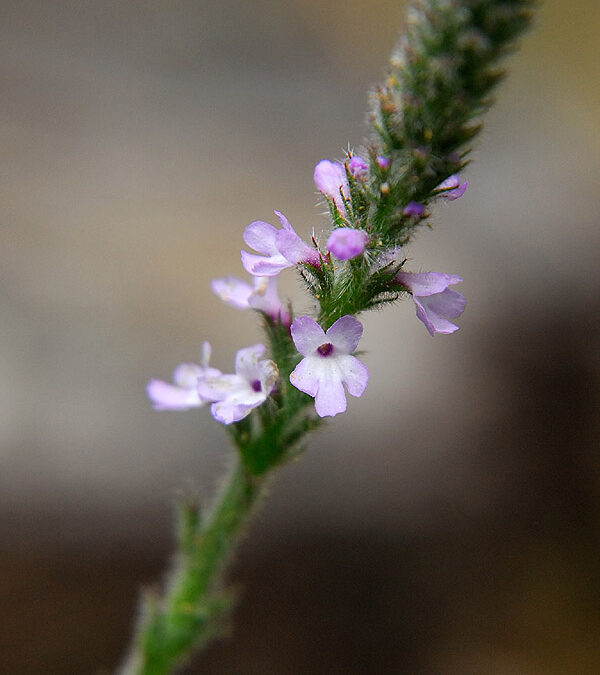
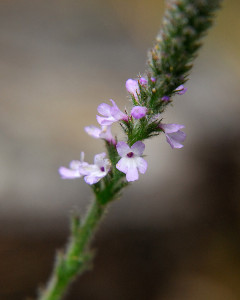
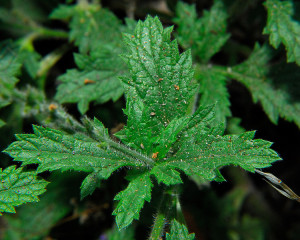
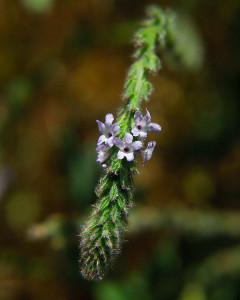
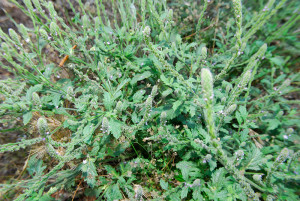
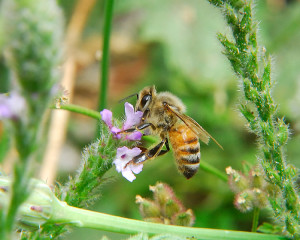
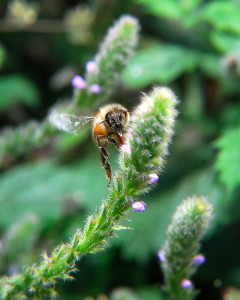
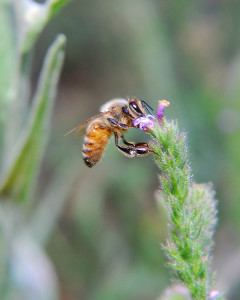
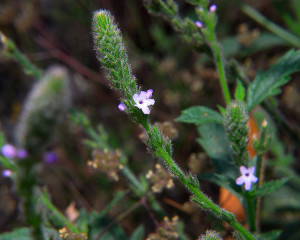







Sweet and important plant and great honeybee shot!
Wildflowers are so beautifully understated and this is no exception. Where would bees be without Verbena? Lovely to see – thank you Clare
Laura
lovely, such a beautiful fragile looking Verbena.
Beautiful plants with leaves and flowers to admire. In a way, they resemble basil in having columnar flowers, where little buds are assembled on a spike reaching for the sun…. and the little bud will take turns to flower. Cheers, have a nice day ~bangchik
Thats a little beauty for this time of year Clare. Nearly all of our wildflowers have gone into dormancy aswell so I can just imagine that your verbena must look like a little jewel amethyst amongst all the browns of the sedges just now.
You are doing a great job of managing the land, which is what good gardeners should do. Not forcing the land to conform to our ideals, no matter what, but enabling the land to reach its full potential to provide sustenance to body and spirit, for both man and creatures, large and small. It is always a pleasure to read your posts!
I love our native Californian verbenas. We’ve got none here in our dry south facing chaparral, but I’ve seen them growing closer to local patches of evergreen mixed forest, in the north facing slopes, or higher up in altitude. Places with a bit more moisture than we have at home.
Dear Clare, Your native Verbena looks most attractive and, if as you say, the deer ignore it, that is an addd bonus indeed. It does seem to me that your farm accomodates such a wonderful variety of wildflowers which are so important for sustaining a happy balance with Nature.
For some reason, my email subscription to your site seems to have gone wrong. But, I have eventually found my way here!
I’ve always enjoyed coming across these in a meadow. Thank you so much for the detailed information. I wonder if there is an Eastern version?
Don’t you just love it when a wonderful native pops up on its own. My mom had a native salvia pop up and put on quite a show earlier this year. Sometimes being a lazy weeder has its benefits.
Sometimes seeds in the ground remain dormant until they are exposed to feel the warmth of the sun. It’s like waking up from their sleep because the sun is shining on their “eyes”. 🙂
Although I like their benefits to the pollinators, I’m sure I don’t have enough room to accomodate Verbena lasiostachys in my small garden.
I love the tiny flowers of all types of Verbena. I had a Goodding’s Verbena come up from seed earlier this year 🙂
Wow! How did you get the bees to do that? They look like they were posed by an Art Director!
Sounds like the perfect plant for open space. And it sounds like you’ve got a lot. I think it would look too weedy in a formal garden as you said, but your pics are great. They might convince me otherwise.